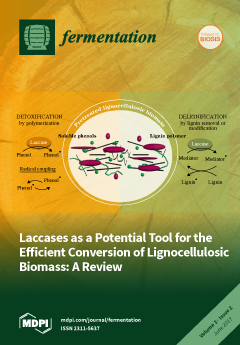While chiral 2,3-Butanediol (2,3-BD) is currently receiving remarkable attention because of its numerous industrial applications in the synthetic rubber, bioplastics, cosmetics, and flavor industries, 2,3-BD-mediated feedback inhibition of
Paenibacillus polymyxa DSM 365 limits the accumulation of higher concentrations of 2,3-BD in the bioreactor
[...] Read more.
While chiral 2,3-Butanediol (2,3-BD) is currently receiving remarkable attention because of its numerous industrial applications in the synthetic rubber, bioplastics, cosmetics, and flavor industries, 2,3-BD-mediated feedback inhibition of
Paenibacillus polymyxa DSM 365 limits the accumulation of higher concentrations of 2,3-BD in the bioreactor during fermentation. The Box-Behnken design, Plackett-Burman design (PBD), and response surface methodology were employed to evaluate the impacts of seven factors including tryptone, yeast extract, ammonium acetate, ammonium sulfate, glycerol concentrations, temperature, and inoculum size on 2,3-butanediol (2,3-BD) production by
Paenibacillus polymyxa DSM 365. Results showed that three factors; tryptone, temperature, and inoculum size significantly influence 2,3-BD production (
p < 0.05) by
P.
polymyxa. The optimal levels of tryptone, inoculum size, and temperature as determined by the Box-Behnken design and response surface methodology were 3.5 g/L, 9.5%, and 35 °C, respectively. The optimized process was validated in batch and fed-batch fermentations in a 5-L Bioflo 3000 Bioreactor, and 51.10 and 68.54 g/L 2,3-BD were obtained, respectively. Interestingly, the production of exopolysaccharides (EPS), an undesirable co-product, was reduced by 19% when compared to the control. These results underscore an interplay between medium components and fermentation conditions, leading to increased 2,3-BD production and decreased EPS production by
P. polymyxa. Collectively, our findings demonstrate both increased 2,3-BD titer, a fundamental prerequisite to the potential commercialization of fermentative 2,3-BD production using renewable feedstocks, and reduced flux of carbons towards undesirable EPS production.
Full article





